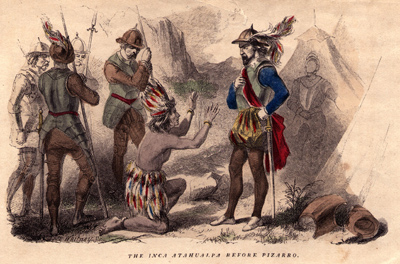Pizarro traps Incan emperor Atahualpa
On November 16, 1532, Francisco Pizarro, the Spanish explorer and conquistador, springs a trap on the Incan emperor, Atahualpa. With fewer than 200 men against several thousand, Pizarro lures Atahualpa to a feast in the emperor’s honor and then opens fire on the unarmed Incans. Pizarro’s men massacre the Incans and capture Atahualpa, forcing him to convert to Christianity before eventually killing him.
Pizarro’s timing for conquest was perfect. By 1532, the Inca Empire was embroiled in a civil war that had decimated the population and divided the people’s loyalties. Atahualpa, the younger son of former Incan ruler Huayna Capac, had just deposed his half-brother Huascar and was in the midst of reuniting his kingdom when Pizarro arrived in 1531, with the endorsement of Spain’s King Charles V. On his way to the Incan capital, Pizarro learned of the war and began recruiting soldiers still loyal to Huascar.
Pizarro met Atahualpa just outside Cajamarca, a small Incan town tucked into a valley of the Andes. Sending his brother Hernan as an envoy, Pizarro invited Atahualpa back to Cajamarca for a feast in honor of Atahualpa’s ascendance to the throne. Though he had nearly 80,000 soldiers with him in the mountains, Atahualpa consented to attend the feast with only 5,000 unarmed men. He was met by Vicente de Valverde, a friar traveling with Pizarro. While Pizarro’s men lay in wait, Valverde urged Atahualpa to convert and accept Charles V as sovereign. Atahualpa angrily refused, prompting Valverde to give the signal for Pizarro to open fire. Trapped in tight quarters, the panicking Incan soldiers made easy prey for the Spanish. Pizarro’s men slaughtered the 5,000 Incans in just an hour. Pizarro himself suffered the only Spanish injury: a cut on his hand sustained as he saved Atahualpa from death.
Realizing Atahualpa was initially more valuable alive than dead, Pizarro kept the emperor in captivity while he made plans to take over his empire. In response, Atahualpa appealed to his captors’ greed, offering them a room full of gold and silver in exchange for his liberation. Pizarro consented, but after receiving the ransom, Pizarro brought Atahualpa up on charges of stirring up rebellion. By that time, Atahualpa had played his part in pacifying the Incans while Pizarro secured his power, and Pizarro considered him disposable. Atahualpa was to be burned at the stake—the Spanish believed this to be a fitting death for a heathen—but at the last moment, Valverde offered the emperor clemency if he would convert. Atahualpa submitted, only to be executed by strangulation. The day was August 29, 1533.
Fighting between the Spanish and the Incas would continue well after Atahualpa’s death as Spain consolidated its conquests. Pizarro’s bold victory at Cajamarca, however, effectively marked the end of the Inca Empire and the beginning of the European colonization of South America.
For more events of November 16, visit History.com
For more information about Atahualpa click on the photo above.
